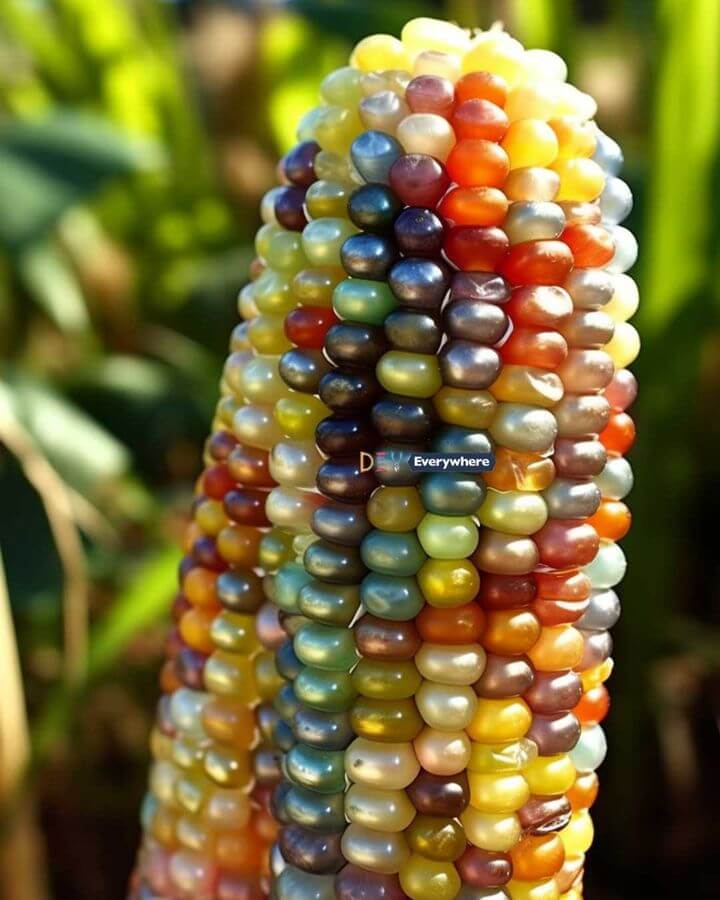If you’ve ever come across corn with dazzling, jewel-toned kernels that seem almost too beautiful to be real, you’ve likely encountered Glass Gem corn. This extraordinary corn variety has captivated gardeners, artists, and nature lovers worldwide with its vibrant, multicolored appearance.
In this article, we’ll explore the fascinating story behind Glass Gem corn, its distinct characteristics, and how you can grow it yourself.
The History and Origins of Glass Gem Corn
Unlike genetically modified or modern hybrid crops, Glass Gem corn is the product of careful selection and traditional breeding. It was developed by Carl Barnes, a Cherokee farmer from Oklahoma, who had a deep appreciation for heirloom corn varieties.
Through years of dedicated crossbreeding, Barnes selectively cultivated corn strains with the most vivid and striking colors. His patience and expertise eventually led to the creation of Glass Gem corn, a variety unlike any other.
How Glass Gem Corn Differs from Traditional Corn
Glass Gem corn stands out from conventional corn varieties in several key ways, particularly in its appearance and purpose. Here’s what sets it apart:
1. A Kaleidoscope of Colors
The most eye-catching feature of Glass Gem corn is its stunningly colorful kernels. While standard corn varieties typically have yellow or white kernels, Glass Gem corn showcases a dazzling mix of red, blue, green, yellow, purple, and more. This unique coloration gives it its signature “glass-like” or “gem-like” effect.
2. Primarily Grown for Decoration
Unlike sweet corn or field corn, Glass Gem corn is mainly cultivated for its ornamental value. Its vibrant kernels make it a popular choice for decorations, including centerpieces, wreaths, and seasonal displays.
3. Edible but Not Typically Grown for Food
While technically edible, Glass Gem corn isn’t commonly used for fresh consumption. Its taste and texture differ from sweet corn, making it less desirable for eating. However, some gardeners do grind its kernels into cornmeal or use them for popcorn, though the flavor is distinct from conventional varieties.
4. A Treasured Heirloom Variety
Glass Gem corn is classified as an heirloom variety, meaning it has been preserved and passed down through generations. Unlike hybrid corn varieties bred for high yields and taste, heirloom corn like Glass Gem is valued for its historical and cultural significance.
5. Wind-Pollinated Like Other Corn Varieties
Similar to other types of corn, Glass Gem corn relies on wind for pollination. To ensure the best results, it is often grown in blocks rather than single rows, which helps promote even pollination and enhances the formation of colorful kernels.
6. Growing Conditions and Care
The cultivation requirements for Glass Gem corn are similar to those of traditional corn. It thrives in warm weather, well-drained soil, and full sunlight. However, since it is often grown for ornamental purposes, gardeners may put extra care into soil preparation and plant maintenance to ensure its striking colors develop fully.
How Glass Gem Corn Is Grown Today
Today, Glass Gem corn is grown by a variety of individuals and organizations, including home gardeners, small-scale farmers, and seed conservationists. Its unique appearance and historical importance have made it a favorite among those who appreciate heirloom crops.
Many people cultivate Glass Gem corn for decorative purposes, incorporating it into garden displays, artistic projects, and floral arrangements. Due to its eye-catching colors, it serves as a standout feature in both gardens and home decor.
Additionally, seed banks and preservation groups actively grow and distribute Glass Gem corn to protect its genetic heritage. These organizations ensure that rare and culturally significant crops like Glass Gem continue to thrive for future generations.
Though primarily grown for its aesthetic appeal, some gardeners experiment with using the kernels for homemade cornmeal or popcorn. While it may not taste like traditional sweet corn, its versatility adds to its appeal among plant enthusiasts.
Final Thoughts
Glass Gem corn is more than just a plant—it’s a living piece of history and a natural work of art. Whether you’re drawn to it for its stunning colors, its rich cultural background, or its role in heirloom seed preservation, this unique corn variety is a rewarding addition to any garden.
Consider planting Glass Gem corn and experience the beauty of nature’s artistry firsthand!
